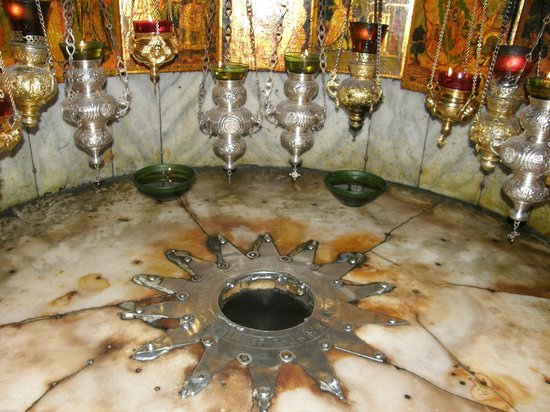Church of the Nativity

The Church of the Nativity is a basilica located in Bethlehem, in the disputed territories of Judea and Samaria, also known as the West Bank.
The church was originally commissioned in 327 by Constantine the Great and his mother Helena over the site that was traditionally considered to be located over the cave that marks the birthplace of Jesus. The Church of the Nativity site’s original basilica was completed in 339 and destroyed by fire during the Samaritan Revolts in the 6th century. A new basilica was built 565 by Justinian, the Byzantine Emperor, restoring the architectural tone of the original. The site of the Church of the Nativity has had numerous additions since this second construction, including its prominent bell towers. Due to its cultural and geographical history, the site holds a prominent religious significance to those of the Christian faith.
The site of the Church of the Nativity is a World Heritage Site, and was the first to be listed under Palestine by the United Nations Educational, Scientific and Cultural Organization (UNESCO). The site is also on UNESCO’s List of World Heritage in Danger.
First-century holy site (c. 4–6 – 327 AD)
The holy site, known as the Grotto, that the Church of the Nativity sits atop, is today associated with the cave in which the birth of Jesus of Nazareth is said to have occurred. In 135, Hadrian is said to have had the Christian site above the Grotto converted into a worship place for Adonis, the Greek god of beauty and desire. A father with the Church of the Nativity, Jerome, noted before his death in 420 that the holy cave was at one point consecrated by the heathen to the worship of Adonis, and that a pleasant sacred grove was planted there in order to wipe out the memory of Jesus. Although some modern scholars dispute this argument and insist that the cult of Adonis-Tammuz originated the shrine and that it was the Christians who took it over, substituting the worship of Jesus, the antiquity of the association of the site with the birth of Jesus is attested by the Christian apologist Justin Martyr (c. 100 – 165 ), who noted in his Dialogue with Trypho that the Holy Family had taken refuge in a cave outside of town:
But when the Child was born in Bethlehem, since Joseph could not find a lodging in that village, he took up his quarters in a certain cave near the village; and while they were there Mary brought forth the Christ and placed Him in a manger, and here the Magi who came from Arabia found Him.(chapter LXXVIII).
Additionally, the Greek philosopher Origen of Alexandria (185 – c. 254) wrote:
In Bethlehem the cave is pointed out where He was born, and the manger in the cave where He was wrapped in swaddling clothes. And the rumor is in those places, and among foreigners of the Faith, that indeed Jesus was born in this cave who is worshipped and reverenced by the Christians. (Contra Celsum, book I, chapter LI).
Fourth-century basilica, (327 – c. 529/556
The first basilica on this site was begun by Saint Helena, the mother of Emperor Constantine I. Under the supervision of Bishop Makarios of Jerusalem, the construction started in 327 and was completed in 333. Construction of this early church was carried out as part of a larger project following the First Council of Nicaea during Constantine’s reign to build on the supposed sites of the life of Jesus. The design of the basilica centered around three major architectural sections: (1) an octagonal rotunda over the area believed to be where Jesus of Nazareth was born; (2) a boxed atrium area of 148 by 92 feet (45 m × 28 m); and (3) double-aisled forecourt of 95 by 93 feet (29 m × 28 m). The structure was burnt down and destroyed in one of the Samaritan Revolts of 529 or 556, in the second of which Jews seem to have joined the Samaritans.
Current restoration
The Church of Nativity, where many Christians believe Jesus Christ was born, in Bethlehem, Disputed Territories, is currently undergoing a major renovation. The Palestinian Presidential Committee for the Restoration of the Nativity Church commenced a massive rehabilitation of the church with the blessings of the Catholic, Greek Orthodox and Armenian Churches, in September 2013. The work is being done by Piacenti S.p.A., an Italian restoration company.
In July 2016, Italian restoration workers uncovered a seventh mosaic angel in the Church of the Nativity which was previously hidden under plaster. The seventh angel was discovered by Silvia Starinieri Piacenti using a thermography technique that scans solid surfaces in the search for works hidden underneath them.
World Heritage Site
In 2012, the church complex became the first Palestinian site to be listed as a World Heritage Site by the World Heritage Committee at its 36th session on 29 June. It was approved by a secret vote of 13–6 in the 21-member committee, according to UNESCO spokeswoman Sue Williams, and following an emergency candidacy procedure that by-passed the 18-month process for most sites, despite the opposition of the United States and Israel. The site was approved under criteria four and six. The decision was a controversial one on both technical and political terms. It has also been placed on the List of World Heritage in Danger as it is suffering from damages due to water leaks,
Source : wikipedia
https://www.youtube.com/watch?v=NrMior480Ew
https://www.youtube.com/watch?v=2PjR6frXDCw
https://www.youtube.com/watch?v=kLzKXhbumL8
Reviews
https://goo.gl/ixkab1


Rate this article